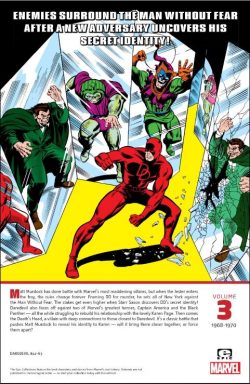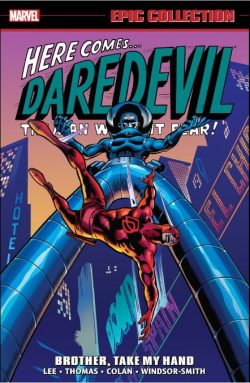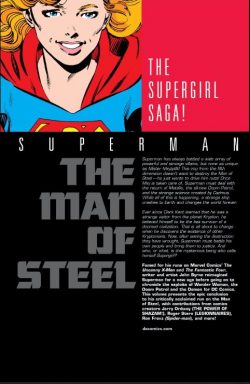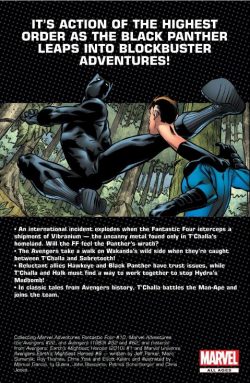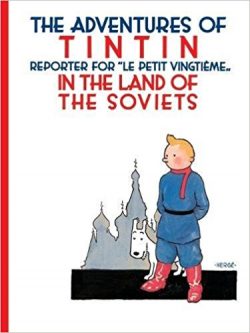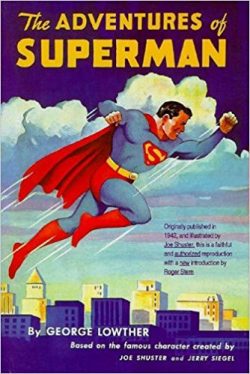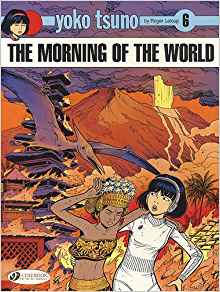
By Roger Leloup translated by Jerome Saincantin (Cinebook)
ISBN: 978-1-84918-082-5
Indomitable intellectual adventurer Yoko Tsuno debuted in 1970 with the September 24th 1970 edition of Le Journal de Spirou and is still delighting regular readers and making new fans to this day. Her astounding all-action, uncannily accessible exploits are amongst the most intoxicating, absorbing and broad-ranging comics thrillers ever created.
The globe-girdling, space-&-time-spanning serial saga of the slim, slight Japanese technologist-investigator was devised by monumentally multi-talented Belgian maestro Roger Leloup who began his spellbinding solo career after working as a studio assistant on Hergé’s Adventures of Tintin.
Compellingly told, superbly imaginative and – no matter how implausible the premise of any individual yarn – always solidly grounded in hyper-realistic settings underpinned by authentic, unshakably believable technology and scientific principles, Leloup’s illustrated escapades were at the vanguard of a wave of strips revolutionising European comics in the mid-1970s.
That long-overdue attitude adjustment saw the rise of many competent, clever and brave female protagonists, all taking their places as heroic ideals beside the boys to uniformly elevate Continental comics. Best of all, the majority of their exploits are as engaging and empowering now as they ever were, and none more so than the trials and tribulations of Yoko Tsuno.
Her very first outings (the still unavailable and untranslated Hold-up en hi-fi, La belle et la bête and Cap 351) were simple introductory vignettes before the superbly capable engineer and her valiant if less able male comrades Pol Paris and Vic Van Steen properly hit their stride with premier full-length saga Le trio de l’étrange in 1971 in Spirou‘s May 13th issue…
There have been 28 European albums to date – with a 29th being completed as we read this…
Yoko’s exploits include explosive escapades in exotic corners of our world, time-travelling jaunts and sinister deep-space sagas with the secretive, disaster-prone alien colonists from planet Vinea. However, for the majority of English translations thus far, the close encounters have been more-or-less side-lined in favour of intriguing Earthly exploits, but this tale stays strictly Earthbound while plumbing the depths of the fantastic…
Today’s particular tale was originally serialised in Spirou #2613-2630 and collected in 1988 as 17th album Le Matin du monde. Due to the exigencies of publishing it reached English eyes as Yoko’s sixth Cinebook outing; a time-bending mystery of glamour and action shedding a fraction of light on Yoko’s own shrouded origins…
It begins with Yoko and her new ward Morning Dew testing a new jet over Indonesia before reuniting with temporal refugee Monya. This time-travelling expatriate from 3872 AD (see The Time Spiral for further details) has had to settle in the present after her own timeline was overwritten, but she’s had a hard time adjusting and despite her best intentions regularly risks catastrophe by visiting other time-periods…
Monya originally came back in time to prevent a scientific experiment which would have resulted in Earth’s destruction by her own era. The voyager witnessed her father’s death and the planet turned to a cinder, relative moments before arriving in Yoko’s locale, so her predilection for exploration and meddling in earlier time periods is perhaps understandable…
Now, though, she’s gone too far: stealing a gold statue from its rightful era and endangering the life of a native…
Urgently summoned to help fix things, Yoko, Vic and Pol are quickly apprised of the situation. Monya has taken a sacred temple statue of a dancer from 1350 AD, a short time before history records the eruption of the Agung volcano and eradication of the entire community and civilisation dwelling there. Technically, Monya’s actions should cause no disruption to the timeline, but it has resulted in the long-dead priests condemning native dancer Narki to death for the crime…
A heated debate over the morality of keeping the immensely valuable statue versus using their time machine and attempting to save the life of a woman already dead for centuries consumes the adults. It only ends when Monya’s new acquaintance Mike – an obsessive religious fanatic – traps them all in the barn housing the chronal craft and sets it afire.
Compelled to use the time engine to save themselves, the entire party is plunged back to 1350 where Narki is condemned to die…
Befriending the local villagers, the travellers learn that the innocent scapegoat has been taken to the capital. Swiftly following, Yoko and Monya find her in a drugged state and determined to sacrifice herself to “winged demons†plaguing the city. Most confusingly, as they struggle to rouse her, Yoko realises that – somehow – she recognises the doomed Narki…
Desperate for solutions, Monya tries unsuccessfully to return the statue to the Brahmin priests, even as Yoko and her comrades assemble some clever 20th century kit they’d providentially stowed aboard the time-ship. Despite all their efforts, Narki is left to the mercies of the demons, and only Yoko and Vic’s spectacular intervention saves her from what turn out to be savage survivors of antediluvian vintage…
Yet, even after destroying one of the flying monsters and snapping Narki out of her trance, the future heroes are unable to save the damsel in distress. Accusing them of killing the gods’ messenger, Narki swears to throw herself into the now-erupting Agung volcano to expiate her sins and save everybody…
That pointless gesture is applauded by the priests, but again thwarted by Yoko and Vic, who snatch the dancer from the edge of fiery doom. They are, however, helpless to save the rest of the populace from the inescapable judgement of history and one of the greatest volcanic eruptions of all time…
Now the sole survivor of her civilisation, Narki makes no protest as Monya relocates her to another time and place she has extensively studied. And when the survivor is left with villagers in 1520 AD Borneo, Yoko realises with a shock how she knows the tragic temple dancer…
Complex, rocket-paced, explosively exciting and subtly suspenseful, this beguiling brush with paradox and passion blazes with thrills and chills, delivering a powerfully moving denouement which again affirms Yoko Tsuno as a top-flight trouble-shooter.
As always, the most effective asset in these breathtaking tales is the amazingly authentic and staggeringly detailed draughtsmanship and storytelling, which superbly benefits from Leloup’s diligent research and meticulous attention to detail.
The Morning of the World is an epic fantasy spectacle to delight and enthral all lovers of inventive adventure.
Original edition © Dupuis, 1988 by Roger Leloup. All rights reserved. English translation 2011 © Cinebook Ltd.

